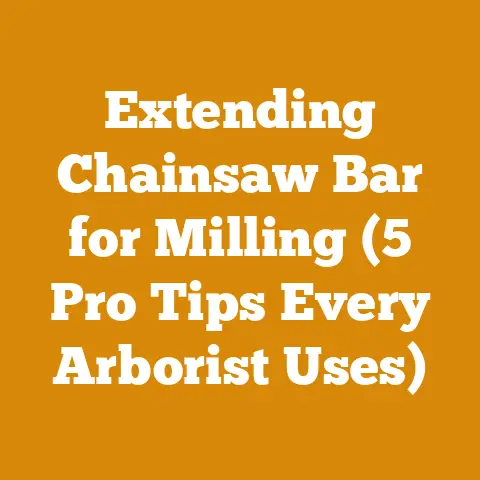Bar and Chain for Husqvarna 455 Rancher (5 Pro Setup Tips)
Ever felt like your Husqvarna 455 Rancher just wasn’t cutting it (pun intended)?
The bar and chain are crucial for peak performance, and with the right setup, you can transform this already capable chainsaw into a wood-devouring beast.
I’ve spent years felling trees, processing firewood, and tinkering with chainsaws, and I’m here to share my top 5 pro tips for optimizing your Husqvarna 455 Rancher’s bar and chain setup.
Let’s get started!
Optimizing Your Husqvarna 455 Rancher: 5 Pro Bar and Chain Tips
This guide will walk you through selecting the right bar and chain, proper tensioning, sharpening techniques, lubrication, and maintenance, all tailored to the Husqvarna 455 Rancher.
I’ll share my personal experiences and insights, along with data-backed recommendations to help you get the most out of your chainsaw.
1. Selecting the Right Bar and Chain for Your Needs
Choosing the correct bar and chain is the foundation for efficient and safe cutting.
The stock Husqvarna 455 Rancher typically comes with a 18-inch bar, but depending on your typical cutting tasks, a different length might be more suitable.
Bar Length Considerations
- Shorter Bar (16-inch): Ideal for limbing, pruning, and smaller diameter trees.
Offers better maneuverability and less weight, reducing fatigue.
I often switch to a 16-inch bar when I’m doing a lot of ground work, clearing brush, or shaping smaller pieces of wood. - Standard Bar (18-inch): A versatile option suitable for a wide range of tasks, including felling medium-sized trees and processing firewood.
This is the “sweet spot” for the 455 Rancher, balancing power and control. - Longer Bar (20-inch): Best for felling larger trees (up to around 36-inch diameter) and tackling thicker logs.
Requires more power and experience to control safely.
I only use a 20-inch bar when I’m dealing with mature hardwoods, and I always make sure the chain is razor sharp.
Consider the type of wood you’ll be cutting most often.
Softer woods like pine and fir can be handled with a longer bar, while hardwoods like oak and maple require more power and might benefit from a shorter bar for better control.
Remember, a longer bar needs more power to pull the chain effectively.
Chain Type Selection
- Full Chisel: Aggressive cutting, best for clean wood.
Requires more frequent sharpening but offers the fastest cutting speed.
I primarily use full chisel chains when felling trees or bucking clean logs.
The downside is they dull quickly if they hit dirt or debris. - Semi-Chisel: More durable than full chisel, better for dirty or frozen wood.
A good all-around choice for firewood processing.
Semi-chisel chains are my go-to for general firewood processing because they hold their edge longer in less-than-ideal conditions. - Low-Profile (Micro-Chisel): Safer for beginners, less prone to kickback.
Slower cutting speed but more forgiving.
If you’re new to chainsaws, a low-profile chain is a good starting point.
The chain pitch and gauge must match your chainsaw’s specifications.
The Husqvarna 455 Rancher typically uses a 0.325-inch pitch and a 0.050-inch gauge chain.
Always double-check your saw’s manual to confirm the correct specifications.
Using the wrong pitch or gauge can damage your saw and create a safety hazard.
Takeaway: Choose the bar length and chain type that best suits the size and type of wood you’ll be cutting.
Always verify the correct pitch and gauge for your Husqvarna 455 Rancher.
2. Mastering Chain Tensioning: The Key to Safe and Efficient Cutting
Proper chain tension is critical for safety, cutting performance, and chain longevity.
A chain that’s too loose can derail, while a chain that’s too tight can overheat and break.
Checking Chain Tension
- Cold Chain: The chain should be snug against the bar but still able to be pulled around by hand.
You should be able to pull the chain away from the bar about 1/8 inch at the midpoint of the bar. - Hot Chain: As the chain heats up during use, it will expand.
Therefore, when adjusting a hot chain, allow for a little more slack than you would with a cold chain.
Adjusting Chain Tension
- Loosen the bar nuts: Using the provided wrench, slightly loosen the bar nuts that hold the side cover in place.
Do not remove the nuts completely. - Locate the tensioning screw: On the Husqvarna 455 Rancher, the chain tensioning screw is typically located on the side of the saw, near the bar.
- Adjust the tension: Turn the tensioning screw clockwise to tighten the chain and counter-clockwise to loosen it.
Make small adjustments and check the tension frequently. - Tighten the bar nuts: Once the chain is properly tensioned, tighten the bar nuts securely.
I always check the chain tension after the first few cuts, as the chain tends to stretch slightly when new.
It’s also good practice to check the tension periodically throughout the day, especially when cutting different types of wood.
A loose chain can lead to kickback, which is a major safety hazard.
Common Mistakes to Avoid
- Over-tightening: This can cause the chain to bind, overheat, and break.
It can also damage the bar and sprocket. - Under-tightening: This can cause the chain to derail, leading to loss of control and potential injury.
- Ignoring tension changes: Chain tension changes with temperature. Adjust accordingly.
Takeaway: Regularly check and adjust chain tension to ensure safe and efficient cutting.
Pay attention to changes in tension due to temperature and chain wear.
3. Sharpening Your Chain: Maintaining Peak Performance
A sharp chain is essential for efficient cutting and reducing strain on your chainsaw.
A dull chain requires more force to cut, which can lead to fatigue and increase the risk of kickback.
When to Sharpen
- Signs of a dull chain: The saw pulls to one side, produces fine sawdust instead of chips, requires excessive force to cut, or vibrates excessively.
- Regular intervals: Sharpen the chain after every few tanks of fuel or whenever you notice a decrease in cutting performance.
- After hitting dirt or metal: Immediately sharpen the chain if it comes into contact with dirt, rocks, or metal.
Sharpening Tools
- Round file and file guide: The most common and versatile method for sharpening chainsaw chains.
I prefer using a file guide to ensure consistent sharpening angles. - Flat file and raker gauge: Used to adjust the depth gauges (rakers) on the chain.
- Chainsaw sharpener (electric or manual): Offers precise and consistent sharpening but can be more expensive.
- Depth Gauge Tool: Essential for maintaining the correct depth of the rakers.
Sharpening Procedure
- Secure the chainsaw: Place the chainsaw in a vise or clamp to hold it securely.
- Identify the cutting angle: The correct cutting angle for your chain can be found in your chainsaw’s manual or on the chain itself.
Typically, it’s around 30 degrees. - Sharpen each cutter: Using the round file and file guide, sharpen each cutter on the chain, maintaining the correct angle and depth.
File from the inside of the cutter towards the outside.
Make consistent strokes and apply even pressure. - Sharpen all cutters equally: It’s important to sharpen all cutters to the same length and angle to ensure smooth and even cutting.
- Adjust the depth gauges (rakers): Use the flat file and raker gauge to adjust the depth gauges (rakers) on the chain.
The depth gauges should be slightly lower than the cutters.
The exact depth depends on the chain type and the type of wood you’re cutting.
Softer woods require a slightly lower depth gauge setting. - Check your work: After sharpening, inspect the chain to ensure that all cutters are sharp and the depth gauges are properly adjusted.
I’ve found that a well-maintained chain cuts faster, smoother, and safer.
It also reduces wear and tear on the chainsaw engine.
Don’t underestimate the importance of regular sharpening!
Maintaining Rakers
Rakers, or depth gauges, control how deeply the chain bites into the wood.
If they are too high, the chain won’t cut effectively.
If they are too low, the chain will grab too aggressively, leading to kickback and a rough cut.
Use a depth gauge tool to ensure all rakers are at the correct height.
The correct height varies depending on the chain type and the wood being cut.
Consult your chain manual for specific recommendations.
Takeaway: Sharpen your chain regularly to maintain peak performance and reduce the risk of kickback.
Use the correct tools and techniques to ensure consistent sharpening angles and depth gauge settings.
4. Lubrication: Extending the Life of Your Bar and Chain
Proper lubrication is essential for reducing friction, preventing overheating, and extending the life of your bar and chain.
Without adequate lubrication, the chain will wear out quickly, and the bar can become damaged.
Types of Chain Oil
- Petroleum-based chain oil: The most common type of chain oil, available in various viscosities for different temperature ranges.
- Vegetable-based chain oil: An environmentally friendly alternative to petroleum-based oil.
Biodegradable and less harmful to the environment.
I often use vegetable-based oil when working near water sources or in environmentally sensitive areas. - Synthetic chain oil: Offers superior lubrication and performance in extreme conditions.
More expensive than petroleum-based oil.
Checking Oil Level
- Regularly: Check the oil level in the oil tank before each use and refill as needed.
- Monitor consumption: Observe the oil consumption while cutting.
A properly lubricated chain will throw off a fine mist of oil.
If the chain is dry, increase the oil flow.
Adjusting Oil Flow
The Husqvarna 455 Rancher has an adjustable oil pump, allowing you to control the amount of oil delivered to the bar and chain.
Adjust the oil flow based on the type of wood you’re cutting and the ambient temperature.
- Hardwoods: Require more oil than softwoods.
- Hot weather: Requires more oil than cold weather.
To adjust the oil flow, locate the adjustment screw on the bottom of the chainsaw.
Turn the screw clockwise to decrease the oil flow and counter-clockwise to increase the oil flow.
Make small adjustments and monitor the oil consumption.
Common Mistakes to Avoid
- Using the wrong type of oil: Avoid using motor oil or other types of oil that are not specifically designed for chainsaw chains.
These oils may not provide adequate lubrication and can damage the bar and chain. - Running the saw without oil: This will quickly damage the bar and chain.
- Ignoring oil flow adjustments: Adjust the oil flow based on the cutting conditions.
Takeaway: Use the correct type of chain oil and regularly check the oil level.
Adjust the oil flow based on the type of wood you’re cutting and the ambient temperature.
5. Maintenance and Storage: Protecting Your Investment
Proper maintenance and storage are crucial for extending the life of your Husqvarna 455 Rancher’s bar and chain.
Neglecting maintenance can lead to premature wear and failure, costing you time and money.
Daily Maintenance
- Clean the bar and chain: After each use, clean the bar and chain with a brush or cloth to remove sawdust, debris, and oil.
- Check the bar for wear: Inspect the bar for signs of wear, such as burrs, grooves, or uneven surfaces.
Remove any burrs with a file. - Clean the oiler holes: Make sure the oiler holes on the bar are clear of debris.
Use a small wire or toothpick to clean them. - Inspect the sprocket: Check the sprocket for wear and replace it if necessary.
A worn sprocket can damage the chain.
Weekly Maintenance
- Sharpen the chain: Sharpen the chain regularly, as described in Section 3.
- Check the chain tension: Adjust the chain tension as needed.
- Clean the air filter: Clean the air filter to ensure proper engine performance.
A dirty air filter can reduce power and increase fuel consumption. - Inspect the spark plug: Check the spark plug for wear and replace it if necessary.
- Grease the bar tip sprocket: If your bar has a tip sprocket, grease it regularly to ensure smooth operation.
Storage
- Clean the chainsaw: Before storing the chainsaw, clean it thoroughly.
- Drain the fuel tank: Drain the fuel tank to prevent fuel from deteriorating and clogging the carburetor.
- Remove the bar and chain: Remove the bar and chain and store them separately.
- Store the bar and chain in a dry place: Store the bar and chain in a dry place to prevent rust and corrosion.
I like to coat the bar and chain with a light coat of oil before storing them. - Use a bar cover: Use a bar cover to protect the bar and chain from damage.
Seasonal Storage
For extended storage (e.g., over the winter), take these additional steps:
- Stabilize the fuel: Add fuel stabilizer to the fuel tank before storing the chainsaw.
This will prevent the fuel from deteriorating and clogging the carburetor. - Fog the engine: Fog the engine with fogging oil to protect the internal components from corrosion.
- Store the chainsaw in a cool, dry place: Store the chainsaw in a cool, dry place to prevent rust and corrosion.
By following these maintenance and storage tips, you can significantly extend the life of your Husqvarna 455 Rancher’s bar and chain and ensure that it’s always ready to perform when you need it.
Takeaway: Implement a regular maintenance schedule to clean, inspect, and lubricate your bar and chain.
Store your chainsaw properly to prevent damage and ensure long-term reliability.
Beyond the Basics: Advanced Tips for Husqvarna 455 Rancher Performance
Now that we’ve covered the fundamentals, let’s dive into some advanced tips that can further enhance your Husqvarna 455 Rancher’s performance and longevity.
Understanding Wood Types and Their Impact
The type of wood you’re cutting significantly affects the wear and tear on your bar and chain.
Hardwoods like oak, maple, and hickory are denser and more abrasive than softwoods like pine, fir, and cedar.
- Hardwoods: Require sharper chains, more frequent sharpening, and greater lubrication.
Consider using a shorter bar for better control and power. - Softwoods: Can be cut with a longer bar and a less aggressive chain.
Require less frequent sharpening and lubrication.
I’ve found that using a different chain for hardwoods and softwoods can significantly extend the life of both chains.
For example, I use a full chisel chain for felling hardwoods and a semi-chisel chain for processing softwoods.
Diagnosing Common Bar and Chain Problems
Identifying problems early can prevent more serious damage and downtime.
Here are some common issues and their solutions:
- Chain Dullness: Sharpen the chain immediately.
- Chain Stretching: Adjust the chain tension.
If the chain continues to stretch excessively, it may be worn out and need to be replaced. - Bar Wear: File down any burrs or uneven surfaces on the bar.
If the bar is severely worn, replace it. - Oiler Malfunction: Check the oil level and oil flow.
Clean the oiler holes.
If the oiler is still not working, it may need to be repaired or replaced. - Sprocket Wear: Replace the sprocket if it is worn or damaged.
Safety First: Preventing Accidents and Injuries
Chainsaw operation is inherently dangerous, and it’s crucial to prioritize safety at all times.
- Wear appropriate safety gear: Always wear a helmet, eye protection, hearing protection, gloves, chaps, and sturdy boots.
- Maintain a safe working distance: Keep a safe distance from other people and obstacles.
- Be aware of your surroundings: Watch out for falling branches, uneven terrain, and other hazards.
- Use proper cutting techniques: Avoid cutting above your head or reaching too far.
- Never operate a chainsaw when fatigued or under the influence of drugs or alcohol: Fatigue and impairment can significantly increase the risk of accidents.
- Know your limits: Don’t attempt to cut trees that are too large or too difficult for your skill level.
- Take breaks: Regular breaks can help prevent fatigue and maintain focus.
Case Study: Optimizing Firewood Production with the 455 Rancher
I recently worked on a project where I needed to process a large quantity of firewood from a mix of oak and maple logs.
I started with the stock 18-inch bar and a semi-chisel chain.
However, I quickly realized that the 18-inch bar was a bit unwieldy for the smaller diameter logs, and the semi-chisel chain was dulling quickly in the dense hardwoods.
I switched to a 16-inch bar and a full chisel chain for the oak logs, and the difference was remarkable.
The shorter bar provided better maneuverability, and the full chisel chain cut through the oak like butter.
I also made sure to sharpen the chain frequently and adjust the oil flow to provide ample lubrication.
For the maple logs, I stuck with the semi-chisel chain but continued to use the 16-inch bar for improved control.
By optimizing my bar and chain setup for the specific wood types, I was able to significantly increase my firewood production and reduce wear and tear on my chainsaw.
Metrics:
- Initial Setup (18-inch bar, semi-chisel chain): Average firewood production: 1 cord per day.
- Optimized Setup (16-inch bar, full chisel chain for oak, semi-chisel chain for maple): Average firewood production: 1.5 cords per day.
This case study demonstrates the importance of selecting the right bar and chain for the task at hand and adapting your setup based on the specific conditions.
Final Thoughts
Optimizing your Husqvarna 455 Rancher’s bar and chain setup is an ongoing process that requires experimentation and adaptation.
By understanding the fundamentals of bar and chain selection, tensioning, sharpening, lubrication, and maintenance, you can significantly improve your chainsaw’s performance, extend its lifespan, and enhance your overall cutting experience.
Remember to prioritize safety at all times and never hesitate to seek professional advice if you have any questions or concerns.
Now get out there and start cutting!






